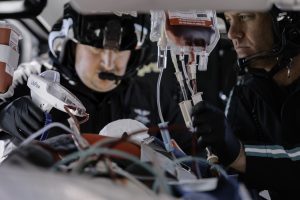
Each year in the United States, approximately 150,000 patients experience a lower extremity amputation.1 When limb amputation occurs due to trauma, early tourniquet application is a life-saving intervention.2 After bleeding has been controlled, reversing the symptoms of shock due to massive blood loss becomes the immediate priority.
Studies show that pre-hospital blood product transfusion within minutes of injury is associated with greater 24-hour and 30-day survival rates.3,4 However, traditional methods of mass volume resuscitation, including pressure bags and rapid infusers, are slow and difficult to manage in trauma settings—particularly in the cramped confines of a medivac helicopter.
The following case illustrates the effectiveness of LifeFlow PLUS, a handheld rapid infuser, for delivering a rapid blood transfusion to a patient who suffered an above-the-knee amputation following a motor vehicle accident (MVA).
Case Presentation
Ochsner Flight Care was called to the scene of an MVA involving a car and a motorcycle with two riders. Upon arrival, the flight nurses were directed to an ambulance containing a 59-year-old female patient who had suffered a near-total amputation above the knee of her left leg.
First responders had already placed a tourniquet around the patient’s leg, but she had already lost a significant amount of blood. She appeared pale with cool, mottled skin and delayed capillary refill. Fortunately, thanks to her helmet, the patient’s head was free of injury other than a minor laceration to her forehead with controlled bleeding. The patient was breathing spontaneously but had diminished breath sounds on the right side. She also sustained an injury to her right wrist with an obvious deformity and tenderness and had a large avulsion to the back of her left hand that was oozing blood.
Assessment of the patient’s vital signs revealed signs of shock, including blood pressure 70/32 (MAP 45), heart rate 110, and SPO2 96% on a non-rebreather mask.
Before the flight team arrived, EMS providers obtained two large-bore peripheral IVs. Normal saline was administered at an open rate by gravity, and the patient was given 1 g of TXA.
Following this assessment, the patient was moved onto the aircraft stretcher for transport to a local medical center.
Management
A rapid blood transfusion was indicated due to the patient’s shock symptoms and injuries. During transport, providers used LifeFlow PLUS to administer two units of packed red blood cells (PRBCs). Approximately 600mL of blood was given in under five minutes.
The patient’s vital signs showed significant improvement ten minutes after the start of the transfusion, including a new blood pressure of 108/60 (MAP 76), heart rate of 96, and SPO2 of 99% on the non-rebreather mask. With these improvements, no additional fluid resuscitation was required during transport.
The patient was given medication for pain and nausea before arriving at the destination hospital. Her bleeding remained controlled, and she was arousable and coherent throughout transport.
Discussion
Effective trauma care hinges on the ability to quickly and efficiently restore lost blood volume and maintain hemodynamic stability. Studies consistently show that pre-hospital blood product transfusion is associated with higher survival rates.3,4 Immediate intervention with a tourniquet to control bleeding, followed by a rapid transfusion, was essential to stabilizing this patient and improving her chance of survival.
In the challenging pre-hospital environment, many methods of rapid blood transfusion, like pressure bags, often prove cumbersome and inefficient. By contrast, LifeFlow PLUS can be set up in minutes and deliver a unit of blood three times faster than a pressure bag. As demonstrated in this case, faster blood product administration results in a shorter time to restored perfusion in trauma patients.
As trauma care continues to evolve, rapid volume resuscitation continues to be a vital intervention that improves outcomes and saves lives. LifeFlow PLUS is an effective tool for fast, controlled transfusions in patients with severe hemorrhagic shock, particularly in pre-hospital care when traditional methods are less efficient.
- Molina CS, Faulk JB. Lower Extremity Amputation. [Updated 2022 Aug 22]. In: StatPearls [Internet]. Treasure Island (FL): StatPearls Publishing; 2024 Jan-. Available from: https://www.ncbi.nlm.nih.gov/books/NBK546594/
- Choksy, S. A., Lee Chong, P., Smith, C., Ireland, M., & Beard, J. (2006). A randomised controlled trial of the use of a tourniquet to reduce blood loss during transtibial amputation for peripheral arterial disease. European journal of vascular and endovascular surgery : the official journal of the European Society for Vascular Surgery, 31(6), 646–650. https://doi.org/10.1016/j.ejvs.2006.03.008
- Shackelford, S. A., Del Junco, D. J., Powell-Dunford, N., Mazuchowski, E. L., Howard, J. T., Kotwal, R. S., Gurney, J., Butler, F. K., Jr, Gross, K., & Stockinger, Z. T. (2017). Association of Pre-hospital Blood Product Transfusion During Medical Evacuation of Combat Casualties in Afghanistan With Acute and 30-Day Survival. JAMA, 318(16), 1581–1591. https://doi.org/10.1001/jama.2017.15097
- Malsby, R. F., 3rd, Quesada, J., Powell-Dunford, N., Kinoshita, R., Kurtz, J., Gehlen, W., Adams, C., Martin, D., & Shackelford, S. (2013). Pre-hospital blood product transfusion by U.S. army MEDEVAC during combat operations in Afghanistan: a process improvement initiative. Military medicine, 178(7), 785–791. https://doi.org/10.7205/MILMED-D-13-00047
- Malsby, R. F., 3rd, Quesada, J., Powell-Dunford, N., Kinoshita, R., Kurtz, J., Gehlen, W., Adams, C., Martin, D., & Shackelford, S. (2013). Pre-hospital blood product transfusion by U.S. army MEDEVAC during combat operations in Afghanistan: a process improvement initiative. Military medicine, 178(7), 785–791. https://doi.org/10.7205/MILMED-D-13-00047

